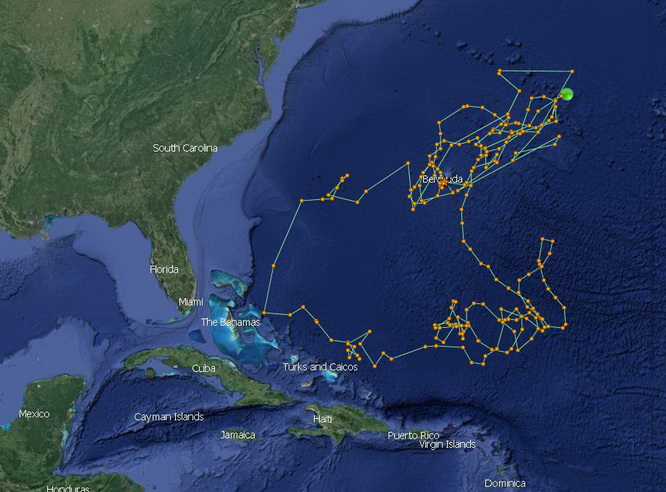 Migrating tiger sharks are returning to almost the same area. Courtesy Nova SouthEastern Univeristy
The tags the scientists attached to tiger sharks near Bermuda lasted up to three years. One shark named Harry, traveled more than 44,000 kilometers in this time. The tracked sharks followed the same migration pattern each year and returned to the same approximate small area in the Caribbean each time. There, the males find female tiger sharks and mate. But why they travel so far north is still an open question. Maybe it is just for feeding.
The migration pattern, similar to that of white sharks in the northern Pacific, might be helpful for conservation. Tiger sharks nearly have the status of threatened, because they are targeted for the soup fin trade. You can find more about the biology of sharks in my e-book, available as an app. See: www.ultimatefishingbooks.com Source: James S. E. Lea, Bradley M. Wetherbee et al: Repeated, long-distance migrations by a philopatric predator targeting highly contrasting ecosystems, in: Scientific Reports 5,
Migrating tiger sharks are returning to almost the same area. Courtesy Nova SouthEastern Univeristy
The tags the scientists attached to tiger sharks near Bermuda lasted up to three years. One shark named Harry, traveled more than 44,000 kilometers in this time. The tracked sharks followed the same migration pattern each year and returned to the same approximate small area in the Caribbean each time. There, the males find female tiger sharks and mate. But why they travel so far north is still an open question. Maybe it is just for feeding.
The migration pattern, similar to that of white sharks in the northern Pacific, might be helpful for conservation. Tiger sharks nearly have the status of threatened, because they are targeted for the soup fin trade. You can find more about the biology of sharks in my e-book, available as an app. See: www.ultimatefishingbooks.com Source: James S. E. Lea, Bradley M. Wetherbee et al: Repeated, long-distance migrations by a philopatric predator targeting highly contrasting ecosystems, in: Scientific Reports 5,This website uses cookies so that we can provide you with the best user experience possible. Cookie information is stored in your browser and performs functions such as recognising you when you return to our website and helping our team to understand which sections of the website you find most interesting and useful.

